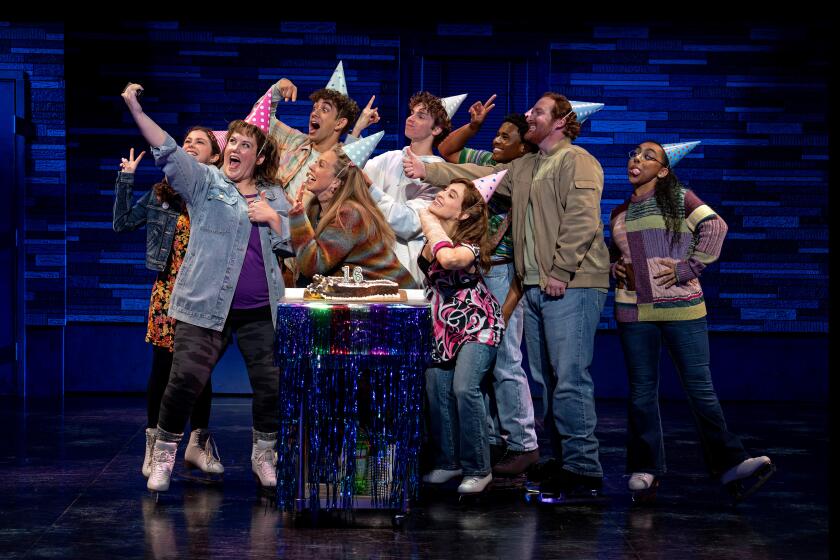Call it the big fad by the Bay
Snow WHITE has had it with waiting for Prince Charming. In a quest for true love, she hits the road.
Whom does she find there? Glinda the Good Witch. Also Paris Hilton, Rush Limbaugh, Bill and Hillary and Ashton and Demi. Michael Jackson, his dangling baby, a PG&E; man, Oprah. Hasidic rabbis singing “Have a tequila.” A gay king who, for a while, was warbling “I’m getting married in the morning.” Elvis, Madonna, the “Queer Eye” guys -- in short, as many headliners as a modern fairy tale could conceivably hold.
And because this is San Francisco, where long, strange trips are a civic hallmark, the heroine’s journey is listed in tour guides all over town. Call it a footnote in the increasingly homogenous world of popular entertainment, but the longest-running theatrical revue in the nation is this most eccentric of sideshows, “Beach Blanket Babylon.”
Cooked up as a lark in the mid-1970s by three friends goofing off on a sidewalk, “Beach Blanket,” as San Franciscans have come to call it, celebrates its 30th anniversary this year.
An offbeat homage to American kitsch from Frankie Avalon movies to the fruity headwear of Carmen Miranda, it was first performed in the back room of the Savoy Tivoli bar in North Beach. Its originators -- an artist named Steve Silver and sisters Nancy and Roberta Bleiweiss, who worked, respectively, in a bank and a bookstore -- were notable chiefly for their limited professional training. Silver once said he’d expected it to fold within six weeks.
Over time, the cabaret-style stage show, revised almost weekly to reflect current events and pop culture, has evolved into San Francisco’s best-known theatrical expression, a $25- to $75-a-ticket phenomenon as zany and self-regarding and tourist-packed as its hometown.
Seen by some 4.5 million people, it has gone on eight times a week, 51 weeks a year for more than 11,000 performances, spoofing everything from “Dynasty” to Donald Trump’s hair. Deaths, lawsuits, natural disasters -- all have struck and none has stopped its curtain from rising. Only the 1989 Loma Prieta earthquake darkened the stage for more than 24 hours.
Though the Guinness World Records doesn’t track theatrical revues, the last long-running show of its kind in the U.S., the “Ziegfeld Follies,” ended in 1931 after 24 years onstage. Playbill Online, which tracks shows on and off-Broadway and in selected cities, cites only two theatrical productions, neither of them revues, that have run longer: “Mousetrap,” the drama that has run since 1952 in London, and “The Fantasticks,” which closed two years ago after nearly 42 years in New York.
Some attribute “Beach Blanket’s” endurance to Silver, who for years planned each show down to the last hatpin. Some credit the show’s topical-but-never-political tone.
And some say it’s one of those fairy tales that’s all in the location.
“ ‘Beach Blanket Babylon’ is to San Francisco what the automobile museum is to Detroit: If you get it, then you get the city,” said USC history professor and retired state librarian Kevin Starr.
Like San Francisco, “Beach Blanket” has experienced the last decade as a time of upheaval. In 1995, Silver died of AIDS, leaving many to wonder whether the show could go on. Childless, he willed it to his widow, Jo Schuman Silver, a wealthy member of the city’s social elite who had been his longtime companion and who had married him shortly before his illness became public.
The transition became a sort of only-in-San Francisco back story, punctuated with boldfaced names and discreet speculation. But for nine years now, Schuman Silver has been assiduously channeling Silver’s vision -- sometimes literally, she recently confided.
“After it happened, my friend Donna Karan called and said, ‘Where were you when he died?’ ” Schuman Silver said, sitting at a cafe table in Club Fugazi, the 393-seat theater where the show has played for all but its first year.
“I told her he died in my arms and she said, ‘His spirit entered your body.’ After that, I started calling all these psychics. Now there’s a spiritual advisor I’ve been using maybe twice a year for seven years and I had her come to the club and feel Steve’s energy -- I didn’t know what to do about the 30th and I had to get a sense of what he wanted.”
A petite, 58-year-old with a mile-a-minute delivery, Schuman Silver caught herself and burst out laughing. “Hey, listen,” she shrugged, throwing her hands up, “you do what works for you.”
Unorthodox history
What Schuman Silver hopes will work for the show and the city that spawned it is a series of special performances in June benefiting established Bay Area arts organizations from the Marin Theater Company to the San Francisco Opera.
Ten years ago, the 20th anniversary was a “Beach Babylon” cast reunion at the grand War Memorial Opera House with an audience of more than 3,000 people and a roster of more than 100 former cast members. The 25th was a tribute to Silver, who by then had died (having pre-choreographed his memorial service). It featured walk-ons by local luminaries in the show’s signature larger-than-life hats and costumes -- former Secretary of State George P. Shultz dressed as Superman, then-Mayor Willie Brown in a crown and scepter as King Willie, and romance author Danielle Steel with the perpetually tanned actor George Hamilton on her arm.
This summer’s celebration, with guest appearances planned by representatives of such dignified groups as the symphony and the ballet, promises to be yet another model of civic decorum. That’s a source of amusement to those who know the show’s unorthodox history, on and offstage.
“It’s just so odd, 30 years later, to be saying it’s a permanent fixture,” said Armisted Maupin, the San Francisco resident and “Tales of the City” author who was among the show’s earliest ticket tearers and who knew Silver when he tap-danced on the sidewalks in a Christmas tree costume.
“My earliest memory was of Steve going into the Savoy Tivoli and pulling the plug on the jukebox so they could perform,” Maupin said.
The show, in fact, was based on a visual aesthetic particular to Silver, a small, whimsical man whose master’s thesis at San Jose State had involved a bocce ball court, five portraits of children, a pony and a little old lady playing piano off-key. Upon graduation, he created a company called Rent-a-Freak that staged “happenings,” as they were then called, at cocktail parties and charity functions -- vacant-eyed ballerinas who would hug the walls, then collapse and be carried out by people dressed as little clouds, for example.
Silver’s style won him jobs as a prop man and party planner for the American Conservatory Theater and, through a friend, he was hired in 1970 an assistant art director on the cult film “Harold and Maude.” Meanwhile, through Rent-a-Freak, he came to know the city’s society hostesses and charity fundraisers.
But the seed of “Beach Blanket,” its founders have said, actually came from a Union Street sidewalk, where one night Silver and the Bleiweiss sisters noticed a one-man band playing for spare change.
Nancy Bleiweiss, now a 54-year-old retired businesswoman with homes in Sonoma County and Palm Desert, was then in her 20s and was taking a dance class just for fun. Still in her tap shoes, she had gone to dinner with Silver and friends. After the meal, she said, they asked the musician to play “Tea for Two.” When he couldn’t, they sang it themselves and began to tap-dance.
“People started throwing money. We couldn’t believe it -- we were lousy! But we were doing it together, and when you do something together, people think you’re terrific,” she said with a laugh.
They rushed to Silver’s parents’ house, got some costumes and went back to the sidewalk, hoping to earn enough money for Los Angeles. “Our ultimate goal was to play Hollywood and Vine,” Nancy Bleiweiss recalled.
With Roberta dressed as Santa Claus, Nancy as Carmen Miranda and Silver in his spangled Christmas tree get-up, the three danced and sang such pop tunes as “Close to You” and “Where the Boys Are.” Within a few weekends, hundreds were gathering around.
They never made the trip to L.A. Instead, they expanded the act into a stage show. With more costumes, some recycled, some made of Scotch tape and crepe paper, the revue, initially called “A Valentine’s Show,” was staged as a set of musical skits and puns with a heavy emphasis on retro pop culture. After several weeks, the show was retooled; on June 7, 1974, it reopened as “Beach Blanket Babylon.”
This time, Silver called in a marketing favor from one of his old Rent-a-Freak clients. Charlotte Mailliard Shultz -- then the fundraiser and society hostess Charlotte Mailliard Swig and now wife of George Shultz and the chief of protocol for the Schwarzenegger administration -- had been a fan since Silver helped her find actors for an event she was planning.
“So when it came time for him to have the show, and he said, ‘How do I get the press there?’ I said, ‘You have to create something for them,’ ” Shultz remembered. As it happened, she was throwing a party for her sister-in-law and offered to hold it at “Beach Blanket.”
“We told everyone to wear summer holiday clothes and served fried chicken, watermelon and chocolate-covered ants,” she said. The floor was covered in sand, waiters wore swim trunks and bikinis. Shultz bought out the house at $2.50 a head and supplied an audience that was a who’s who of establishment San Francisco.
The show was an overnight hit -- a development that, in Maupin’s view, was at the time hilariously subversive.
“You have to understand, the show was gay to its very marrow!” he said. “I mean, Glinda the Good Witch, Carmen Miranda and three surfer boys? Onstage at the same time?”
But, he added, it was viewed as mainstream, in part because that was how the city’s tastemakers saw Silver. Until he contracted AIDS, Maupin said, Silver’s homosexuality “was very, very secret.” His art was virtually his sole focus, and he seldom discussed his private life.
Obvious references in the script to gay culture were excised by Silver and oblique ones went over the heads of straight fans -- to Maupin’s chagrin, because he was one of the show’s early gag writers. (One of his lines -- “I just love to feel my pineapples blowing in de breeze!” -- is still in the show.)
Schuman Silver, who met Silver years later during her marriage to retail clothing magnate Adolph Schuman, says she believed he was straight. When they later became involved, she said, Silver told her his illness had been caused by “an adventure.”
“Looking back, it was very odd and a little sad, because at the time the rest of us were celebrating our liberation,” Maupin said. “He listened to all our confessions and fractured love lives but never talked about his own feelings.”
‘San Francisco treasure’
Shows like “Beach Blanket” have a long history in San Francisco, which has had music hall-style revues since the Gold Rush, said historian Starr. “There was a tremendous amount of theatrical life here right from 1849, because you had thousands of single people here looking for entertainment,” he said. “There was a San Francisco songbook in 1850. And that kind of entertainment is intrinsically and dynamically urban. It won’t work anywhere else.”
“Beach Blanket” was able to tap into the city’s particular character, he noted. “San Francisco has always had that endless obsession with itself,” Starr said. “And it has a more developed taste for zaniness than most other cities.”
This may explain why a sizable chunk of its audience consists of locals who have seen it again and again. (And again. The department store magnate Cyril Magnin is said to have seen it some 500 times during his tenure as the city’s chief of protocol.)
It also may be a reason the show has never been franchised. “Beach Blanket” has played Las Vegas and London, briefly, to positive reviews, but David Lincoln King, the show’s general manager, said Silver saw the show chiefly as “a San Francisco treasure.”
“The industry tradition is when you get successful, you tour it, but Steve wasn’t interested in taking it places,” King said. It wasn’t necessary. Like most long-running shows, “Beach Blanket” appeals fundamentally to suburbanites and tourists who since 1962 have underpinned the city’s economy.
San Francisco Chronicle critic Steven Winn has compared it to such theatrical standbys as “Forbidden Broadway” and “Tony n’ Tina’s Wedding” in the sense that it is both expertly performed and “shrewdly calculated to deliver an entertaining evening and ask nothing in return.”
“It’s not too highbrow and not too lowbrow,” said Geraldine O’Brien, arts and tourism manager for the San Francisco Convention & Visitors’ Bureau. “And it’s what people expect from the city -- it’s feel-good, it’s camp.”
In 1977, the relationship between Silver and the Bleiweiss sisters soured. The show -- which broke even almost from the outset -- was increasingly profitable but unlike most productions remained (and still remains) nonunion, which limited the performers’ ability to act elsewhere . Nancy Bleiweiss was starting to get job offers in TV. Distrust simmered. The Bleiweiss sisters left and sued Silver. The bitter legal fight over the creative rights to the show dragged on for nearly six years until a judge ruled in 1983 that Silver was the sole owner of the now-lucrative stage show.
Nancy Bleiweiss went on to act in “Laugh-In” specials and commercials, then married and opened a travel management business in Marina del Rey, which she recently sold. Roberta Bleiweiss, 56, became a theatrical producer and promoter and last year began working in an art and music program in the San Francisco public school system.
“I have no regrets,” said Nancy Bleiwess, who remembers the early years as “a love affair with San Francisco.”
“It was like some Judy Garland-Mickey Rooney movie. I have some great memories.”
Now, Schuman Silver is at the helm and veteran cast member Kenny Mazlow is directing, but the staging remains essentially unchanged from its first years. Snow White’s search for a boyfriend is the hook for a series of nonstop spoofs, skits and sight gags. (Ashton Kutcher follows Demi Moore onto the stage on a tricycle; Limbaugh enters to the tune of “White Rabbit,” drumming on a giant bottle of pills.)
Ten cast members play multiple roles as Snow White’s search takes her to various locations. At each stop, she is greeted by an interlocutor -- in this case, Val Diamond, the show’s longest-serving cast member and a linchpin of the production, now gliding across the stage in a massive hat depicting the San Francisco skyline, now moving the audience to tears with her rendition of “Anyone Who Had a Heart.”
The comedy, meanwhile, ranges from throwaway to timeless. Some of the bits date back decades. The show starts, for example, with the curtain parting on an actor dressed as the Planter’s Peanuts pitchman, Mr. Peanut. “This is the city -- San Francisco,” a narrator intones, “Dragnet”-like. “There are 2 million nuts. This is one of them.” (Bada boom.)
The bread and butter of the show, though, is its topical humor. The script is updated constantly. As same-sex couples were lining up to be married in February, for example, Schuman Silver and Mazlow were rewriting pink-wigged King Louie’s explanation about why he couldn’t possibly be Snow White’s true love: “I’m get-ting married in the morrrrrninnng!” the fey king sings out. “Ding-dong, I’m going to have it all! I’ll be a twosome, thanks to Mayor Gavin Newsom! It’s happening at City Hall.”
“Most of the people in the Bay Area know they can come three or four times and always see something new, because it’s always changing,” says Schuman Silver, who has been guided by Silver’s notes and sketches as well as an innate understanding of his sensibility.
A cousin of recording industry legend Clive Davis, she is a former advertising executive and talent agent. “It sounds weird, but I always just ‘got’ him,” she said. “We had the same humor. We were soul mates.”
That, she believes, has been the most recent key to the show’s longevity.
“Even now, I feel him,” she said. “I’m constantly asking, ‘What would Steve do?’ ”
More to Read
The biggest entertainment stories
Get our big stories about Hollywood, film, television, music, arts, culture and more right in your inbox as soon as they publish.
You may occasionally receive promotional content from the Los Angeles Times.










